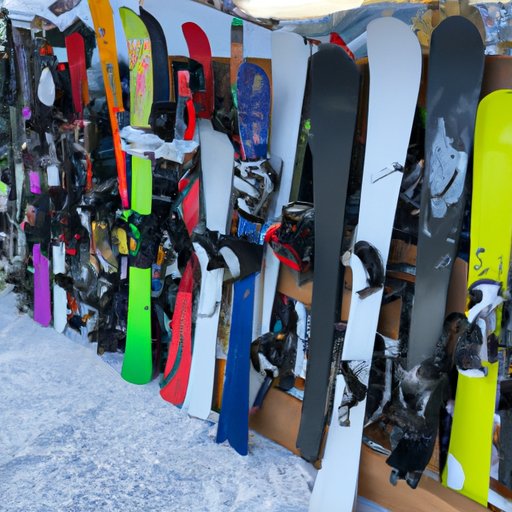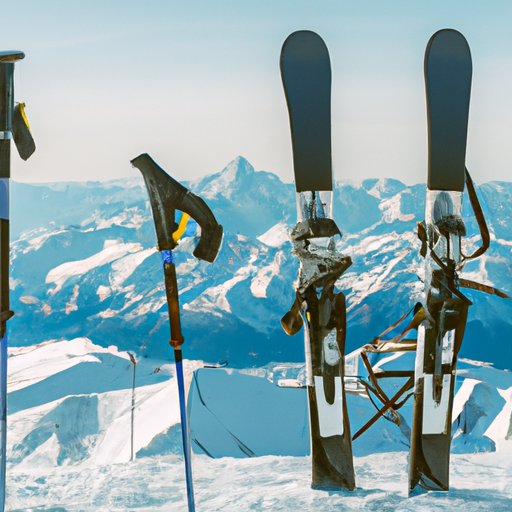Introduction
For many winter sports enthusiasts, skiing is an essential part of the vacation experience. But traveling with skis can be a logistical challenge. From researching ski destinations and creating an effective packing list to understanding ski equipment rental options and navigating airports, there’s a lot to consider when planning a ski trip. In this article, we’ll provide a comprehensive guide to traveling with skis, so you can make the most of your time on the slopes.
Researching Ski Destinations
When it comes to choosing a ski destination, it pays to do your research. According to a survey by the National Ski Areas Association (NSAA), “the primary criteria used by skiers and snowboarders in selecting a ski area are snow quality and terrain.” Other factors to consider include proximity to major cities, resort amenities, and cost.
Tips for Choosing the Right Resort and Accommodations
First, decide if you want to stay at a ski-in/ski-out resort or if you don’t mind driving to the slopes. If you choose to stay at a resort, look for one that offers amenities such as ski storage, a pool or hot tub, and ski/snowboard rentals. You should also check reviews to get an idea of the resort’s customer service and overall atmosphere.
Next, think about the type of accommodations you prefer. Do you want to stay in a hotel, condo, or private home? Consider the size of the space and number of bedrooms needed for your group, as well as the types of amenities offered, such as kitchen facilities and Wi-Fi.
Comparing Prices and Amenities
Once you’ve narrowed down your options, compare prices and amenities. Some resorts offer discounted rates for midweek stays, while others may offer meal plans or discounted lift tickets. Look for packages that combine lodging, lift tickets, and lessons to save money. Additionally, you can often find discounts on sites like Groupon and Travelocity.
Benefits of Staying at a Ski-Friendly Resort
Staying at a ski-friendly resort can be a great way to maximize your ski vacation. Not only will you have easy access to the slopes, but you’ll also benefit from on-site amenities such as ski storage, equipment rentals, and ski school. Plus, ski-friendly resorts often offer discounts on lift tickets and other activities, so you can save money while enjoying all the perks of a ski resort.

Creating an Effective Packing List for Ski Travel
Once you’ve chosen a destination, it’s time to start packing. Knowing what to bring on a ski trip can be overwhelming, so it’s important to create an effective packing list. Start by thinking about the type of clothing and gear you’ll need for your trip, and be sure to pack items that will keep you warm and comfortable on the slopes.
What to Pack for Your Ski Trip
The first step is to make sure you have the right clothing and gear. Begin by packing a few base layers, such as long underwear, leggings, and a light jacket. You’ll also need a pair of waterproof pants and a waterproof jacket. Make sure to bring warm socks, gloves, and a hat or beanie, too.
Essential Clothing and Gear
In addition to the basics, there are a few other essential items you should bring on your ski trip. Sunglasses and sunscreen are must-haves, as well as a neck gaiter or scarf. Also, don’t forget your ski goggles and helmet if you plan to ski off-piste. Finally, you’ll need to bring a ski bag to transport your skis safely.
Other Important Items to Bring
Finally, there are a few other items you should bring on your trip. Pack a first aid kit and any over-the-counter medications you might need. You’ll also want to bring snacks and energy bars to keep you fueled throughout the day. And don’t forget to bring a camera to capture all your memories!

Making the Most of Your Time on the Slopes: Planning a Ski Trip Itinerary
Once you’ve packed all the essentials, it’s time to start planning your ski trip itinerary. Planning ahead is key to getting the most out of your ski vacation. Knowing where you’re going and when will help you make the most of your time on the slopes.
Planning Your Ski Routes
Before you hit the slopes, it’s important to map out your ski routes. Research the resort’s trails and determine which ones fit your skill level and interests. If you’re planning to ski off-piste, make sure you have the proper safety equipment and knowledge.
Scheduling Lift Times
Make sure to check the resort’s lift hours and plan accordingly. Many resorts offer early morning and late night sessions, so you can get the most out of your ski days. Additionally, some resorts offer multi-day passes, so you can ski as much as you want without worrying about buying daily lift tickets.
Getting the Most Out of Ski School
If you’re new to skiing or snowboarding, signing up for ski school is a great way to learn the basics and gain confidence on the slopes. Most ski schools offer beginner, intermediate, and advanced classes, so you can find one that fits your needs. Even experienced skiers can benefit from taking a refresher course.

Understanding Ski Equipment Rental Options
If you’re traveling with skis, you’ll need to understand your rental options. Many resorts offer ski equipment rental packages that include skis, boots, poles, and helmets. However, if you’re planning to ski off-piste, you’ll need to rent additional equipment, such as avalanche transceivers, shovels, and probes.
Where to Rent Skis
Before you leave for your ski trip, make sure to research your ski rental options. Many resorts offer on-site rental shops, so you can pick up your equipment when you arrive. Alternatively, you can rent skis online before your trip, which can save you time and money.
Types of Equipment Available
When renting skis, you’ll need to choose between alpine skis, which are designed for groomed runs, and freestyle skis, which are better suited for park and pipe skiing. Additionally, you’ll need to decide between traditional bindings and modern bindings. Traditional bindings are more reliable, while modern bindings offer more control and flexibility.
Tips for Renting Skis
When renting skis, it’s important to choose the right size. Generally, the tip of the ski should reach just above your chin when standing upright. Additionally, make sure to properly adjust your bindings before hitting the slopes. If you’re unsure how to do this, ask an employee at the rental shop for assistance.
Navigating Airports and Airlines with Skis
Finally, if you’re flying to your ski destination, you’ll need to know how to navigate airports and airlines with skis. The good news is that most major airlines allow you to check skis as luggage. However, there are a few steps you should take to ensure your skis arrive safely.
Checking Skis as Luggage
When checking skis as luggage, be sure to use a hard-sided ski bag to protect your equipment. Additionally, wrap your skis in bubble wrap or foam padding to further protect them from damage. Finally, make sure to label your bag clearly, so the airline knows it contains skis.
Shipping Skis Ahead
If you’d rather not check your skis, you can always ship them ahead of time. This is especially helpful if you’re traveling with multiple sets of skis or if you’re worried about your skis getting damaged in transit. Just make sure to choose a reliable shipping company and insure your package.
Travel Insurance Considerations
Finally, don’t forget to purchase travel insurance for your ski trip. Travel insurance can cover lost or stolen ski equipment, medical expenses, and more. So it’s worth investing in a policy to ensure you’re protected in case of any unexpected issues.
Conclusion
Traveling with skis can be a logistical challenge, but with the right preparation, you can make the most of your ski vacation. Start by researching ski destinations and creating an effective packing list. Then, plan an itinerary and understand your ski equipment rental options. Finally, make sure to navigate airports and airlines with skis responsibly. With these tips, you’ll be ready to hit the slopes and enjoy a successful ski trip.
(Note: Is this article not meeting your expectations? Do you have knowledge or insights to share? Unlock new opportunities and expand your reach by joining our authors team. Click Registration to join us and share your expertise with our readers.)
